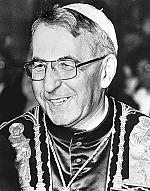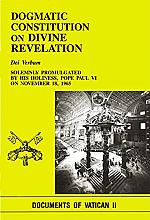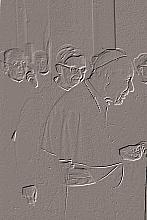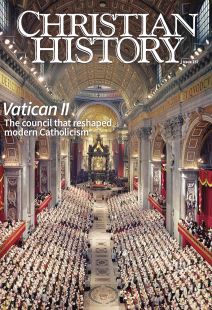Christian History Timeline: Tracing Vatican II
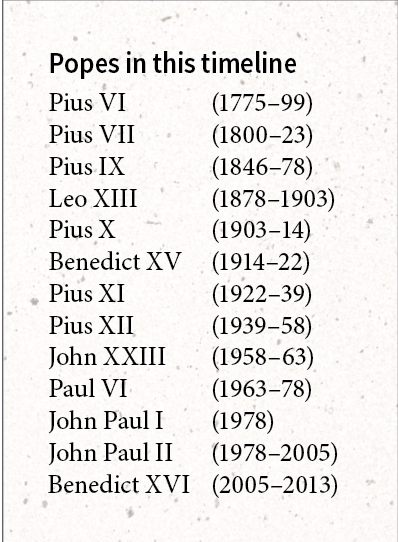
— 1545–63 The Council of Trent convenes as a response to the Protestant Reformation. The Catholic Reformation includes an increase in lay orders, global missions, and a greater dependence of the church on an alliance with Catholic monarchs.
— 1618 The Thirty Years’ War begins, devastating Europe as Catholic and Protestant monarchs struggle for control.
— 1790 The “throne and altar” alliance between the papacy and the secular government dissolves during the French Revolution.
— 1798 Napoleon Bonaparte invades Italy and holds Pope Pius VI prisoner; Pius dies in captivity the next year.
— 1809 Pope Pius VII excommunicates Napoleon for incorporating the Papal States into the French Empire. Napoleon responds by imprisoning him.
— 1814 Napoleon releases Pius VII after forcing him to sign a treaty. Pius VII and subsequent popes attempt to restore the papacy’s relationship with other European powers via more favorable treaties.
— 1848 Revolutionaries assassinate pope-appointed economist Count Pellegrino Rossi in Rome; Pope Pius IX flees during the coup.
— 1850 Pius IX returns to Rome in 1850 after the collapse of the Roman Republic.
— 1864 Pius IX issues the Syllabus of Errors as a decree against “progress, liberalism, and modern civilization.”
— 1868 Pius IX calls for the First Vatican Council.
— 1870 As armed conflict threatens Rome, Vatican I adjourns after the vote defining papal infallibility; it would not officially close until the council fathers vote to begin Vatican II.
— 1879 Pope Leo XIII issues Aeterni Patris, which leads to the dominance of neoscholastic theology. Critics of this approach would eventually come to be known as proponents of nouvelle théologie.
— 1903 Pius X is elected pope and begins a crusade against modernism that targets Catholic intellectuals—censuring, intimidating, and excommunicating many in the process.
— 1910 Pius X orders all ordination candidates to take an “anti-Modernist Oath.”
— 1914 The First World War begins, setting in motion a period of global turmoil. Benedict XV is elected pope.
— 1917 World War I ends. The unified Code of Canon Law gives the papacy more direct control over the Catholic Church. In Russia the Bolshevik revolution topples the czardom.
— 1925 Pope Pius XI establishes the Feast of Christ the King with the encyclical Quas Primas as a response to both communism and rising fascism.
— 1937 Pius XI issues Mit Brennender Sorge, denouncing Nazi positions and infringement on Catholic rights.
— 1939 Pope Pius XI dies; Pius XII begins his 20-year-long papacy. World War II begins, and Pius XII’s response of neutrality garners intense criticism.
— 1945 World War II ends.
— 1950 Pius XII invokes papal infallibility to define the dogma of the Assumption of Mary. He also cracks down on “modernist heresies,” resulting in the censure of suspected modernists, most of whom are associated with nouvelle théologie.
— 1959 After becoming pope in 1958, John XXIII calls for another ecumenical council.
— 1962 The Second Ecumenical Vatican Council opens on October 11, beginning by officially voting to conclude Vatican I. The council immediately turns to issues of reform. In June John XXIII dies, temporarily halting the council. After Paul VI’s election, the council reconvenes in September.
— 1963 The council approves the Constitution of the Sacred Liturgy (Sancrosanctum Concilium).
— 1964 In the midst of deeply divided debates, Paul VI intervenes in mid-November, known as “Black Week.” The council produces the final version of the Dogmatic Constitution on the Church (Lumen Gentium) on November 21.
— 1965 Key declarations on non-Christian religions, religious freedom, and Christian education are approved in October. During council deliberations, Paul VI travels to New York to address the United Nations.
— 1965 On December 7 the council approves the final Constitution on the Church in the Modern World (Gaudium et Spes), and concludes the council the following day.
— 1967 A wave of revival, now known as the Catholic charismatic renewal movement, sweeps across college campuses in the United States and becomes a global phenomenon.
— 1969 The reformed rite of the Mass is produced, introducing changes such as services in the vernacular and expanded roles for laypeople.
— 1972 Theologian David Wells publishes Revolution in Rome, a widely read Protestant assessment of Vatican II.
— 1978 Albino Luciani is elected pope and takes the name John Paul I, honoring his Vatican II predecessors and signifying his commitment to the council. After he dies two weeks later, Karol Wojtyla, his successor, takes the name Pope John Paul II.
— 1983 The Catholic Church produces an updated Code of Canon Law as a result of Vatican II.
— 1992 A new Catholic catechism is produced, also a result of the council.
— 2005 John Paul II dies; Joseph Ratzinger, an influential reform-minded peritus at Vatican II, is elected Pope Benedict XVI. He continues the more conservative interpretation of Vatican II begun by John Paul II.
By the editors
[Christian History originally published this article in Christian History Issue #157 in 2025]
Next articles
Always reforming, always the same
How popes interpreted Vatican II and helped reimagine the church
Barnaby HughesSupport us
Christian History Institute (CHI) is a non-profit Pennsylvania corporation founded in 1982. Your donations support the continuation of this ministry
Donate



